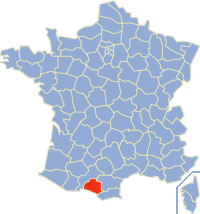| Revision as of 17:39, 27 December 2009 editSmackBot (talk | contribs)3,734,324 editsm Delink dates (WP:MOSUNLINKDATES) using Project:AWB← Previous edit | Revision as of 17:53, 7 February 2010 edit undoLaaknorBot (talk | contribs)122,478 editsm robot Adding: ru:Вернет (концентрационный лагерь)Next edit → | ||
| Line 44: | Line 44: | ||
| ] | ] | ||
| ] | ] | ||
| ⚫ | ] | ||
| ] | ] | ||
| ] | ] | ||
| ] | ] | ||
| ] | |||
| ⚫ | ] | ||
Revision as of 17:53, 7 February 2010


Le Vernet Internment Camp, or Camp Vernet, was a concentration camp in Le Vernet, Ariège, near Pamiers, in the French Pyrenees. It was originally built in June 1918 to house French colonial troops serving in World War I but when hostilities ceased it was used to hold German and Austrian prisoners of war.
Between the wars, it served as a military depot. Towards the end of the Spanish Civil War, in February 1939, it was put to a new use. It became a reception camp for Republicans fleeing from Francisco Franco's armies after the collapse of the Second Spanish Republic. At this time, it held mainly former soldiers from the Republican Durruti Division.
With the outbreak of World War II, the role of the camp was expanded. It was used to house "undesirable" foreigners, in particular, anti-fascist intellectuals and former members of the International Brigades. After the Fall of France on 25 June 1940, it was taken over by the pro-Nazi Vichy France authorities, to house "all foreigners considered suspect or dangerous to the public order".
From 1942, Le Vernet became a transit camp for detained Jews. In June 1944, the last internees were evacuated and deported to the Dachau concentration camp in the "Ghost Train". In total, about 40,000 persons of 58 nationalities were interned in the camp; mainly men but also women and children.
Notable prisoners
- Kurt Julius Goldstein
- Arthur Koestler, who wrote about it in The Invisible Writing and Scum of the Earth
- Rudolf Leonhard, German playwright and communist
- Heinrich Rau
- Sascha Schapiro
- Miguel García Vivancos
- Max Aub
Sources and footnotes
- ^ Template:En iconCamp Vernet Website
- ^ Template:Fr icon Camp Vernet Website
- Template:En icon Ariège history website in English
- Template:Fr icon Ariège history website in French
See also
This Spanish history–related article is a stub. You can help Misplaced Pages by expanding it. |
This French history–related article is a stub. You can help Misplaced Pages by expanding it. |
43°11′43″N 1°36′30″E / 43.19528°N 1.60833°E / 43.19528; 1.60833
Categories: